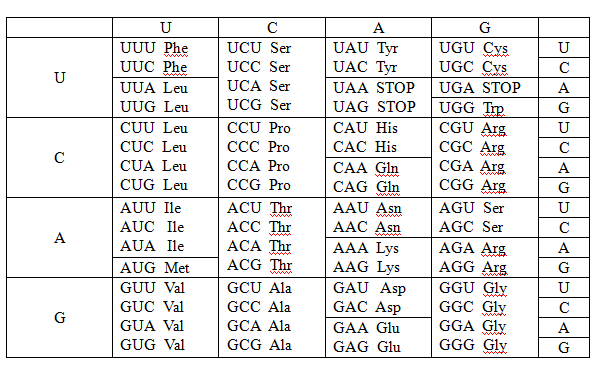
Concept explainers
(a)
Interpretation:
The anticodon and the amino acid of CGG codon should be written.
Concept Introduction:
Anticodon is the tRNA sequence of codon. Each triplet of

(b)
Interpretation:
The anticodon and the amino acid of GGG codon should be written.
Concept Introduction:
Anticodon is the tRNA sequence of codon. Each triplet of nucleic acid represents a single amino acid.

(c)
Interpretation:
The anticodon and the amino acid of UCC codon should be written.
Concept Introduction:
Anticodon is the tRNA sequence of codon. Each triplet of nucleic acid represent a single amino acid.

(d)
Interpretation:
The anticodon and the amino acid of AUA codon should be written.
Concept Introduction:
Anticodon is the tRNA sequence of codon. Each triplet of nucleic acid represent a single amino acid.

(e)
Interpretation:
The anticodon and the amino acid of CCU codon should be written.
Concept Introduction:
Anticodon is the tRNA sequence of codon. Each triplet of nucleic acid represents a single amino acid.

(f)
Interpretation:
The anticodon and the amino acid of GCC codon should be written.
Concept Introduction:
Anticodon is the tRNA sequence of codon. Each triplet of nucleic acid represents a single amino acid.

Want to see the full answer?
Check out a sample textbook solution
Chapter 22 Solutions
GENERAL,ORGANIC, & BIOLOGICAL CHEM-ACCES
- Use the Henderson-Hasselbalch equation to calculate pH of a buffer containing 0.050M benzoic acidand 0.150M sodium benzoate. The Ka of benzoic acid is 6.5 x 10-5arrow_forwardA. Draw the structure of each of the following alcohols. Then draw and name the product you would expect to produce by the oxidation of each. a. 4-Methyl-2-heptanol b. 3,4-Dimethyl-1-pentanol c. 4-Ethyl-2-heptanol d. 5,7-Dichloro-3-heptanolarrow_forwardWhat is the pH of a 1.0 L buffer made with 0.300 mol of HF (Ka = 6.8 × 10⁻⁴) and 0.200 mol of NaF to which 0.160 mol of NaOH were added?arrow_forward
- Can I please get help with this.arrow_forwardDetermine if the following salt is neutral, acidic or basic. If acidic or basic, write the appropriate equilibrium equation for the acid or base that exists when the salt is dissolved in aqueous solution. If neutral, simply write only NR. Be sure to include the proper phases for all species within the reaction. N₂H₅ClO₄arrow_forwardPlease help me with identifying these.arrow_forward
 General, Organic, and Biological ChemistryChemistryISBN:9781285853918Author:H. Stephen StokerPublisher:Cengage Learning
General, Organic, and Biological ChemistryChemistryISBN:9781285853918Author:H. Stephen StokerPublisher:Cengage Learning Organic And Biological ChemistryChemistryISBN:9781305081079Author:STOKER, H. Stephen (howard Stephen)Publisher:Cengage Learning,
Organic And Biological ChemistryChemistryISBN:9781305081079Author:STOKER, H. Stephen (howard Stephen)Publisher:Cengage Learning, Chemistry: Principles and PracticeChemistryISBN:9780534420123Author:Daniel L. Reger, Scott R. Goode, David W. Ball, Edward MercerPublisher:Cengage Learning
Chemistry: Principles and PracticeChemistryISBN:9780534420123Author:Daniel L. Reger, Scott R. Goode, David W. Ball, Edward MercerPublisher:Cengage Learning
 Chemistry for Today: General, Organic, and Bioche...ChemistryISBN:9781305960060Author:Spencer L. Seager, Michael R. Slabaugh, Maren S. HansenPublisher:Cengage Learning
Chemistry for Today: General, Organic, and Bioche...ChemistryISBN:9781305960060Author:Spencer L. Seager, Michael R. Slabaugh, Maren S. HansenPublisher:Cengage Learning Principles of Modern ChemistryChemistryISBN:9781305079113Author:David W. Oxtoby, H. Pat Gillis, Laurie J. ButlerPublisher:Cengage Learning
Principles of Modern ChemistryChemistryISBN:9781305079113Author:David W. Oxtoby, H. Pat Gillis, Laurie J. ButlerPublisher:Cengage Learning





